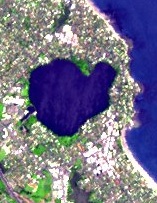Lake Pupuke
| Lake Pupuke | |
|---|---|
 |
|
| Location | North Shore City, North Island, New Zealand |
| Coordinates | 36°46′48″S 174°45′58″E / 36.780115°S 174.766184°ECoordinates: 36°46′48″S 174°45′58″E / 36.780115°S 174.766184°E |
| Lake type | Crater lake |
| Basin countries | New Zealand |
| Max. depth | 57 m (187 ft) |
| Settlements | Takapuna, Milford |
Lake Pupuke is a heart-shaped freshwater lake occupying a volcanic crater (or maar) between the suburbs of Takapuna and Milford on the North Shore of Auckland, New Zealand. The heart shape is a result of its formation by the linking of two circular craters - a larger one forming most of the lake and a smaller one forming the arm in the northeast. Separated from the sea by less than 200 m at one point, it has a circumference of about 4.5 km and reaches 57 m in depth. It is popular for recreational activities and the lakefront property around it.
Other similar craters in the Auckland volcanic field were either buried by later eruptions, or breached by erosion as rainwater collected and overflowed the edge of the crater. Lake Pupuke remains a lake because, unlike the other vents, its eruptions produced substantial lava flows; water can thus escape through cracks in the lava reaching under the crater wall, creating a series of freshwater springs along the beaches between Takapuna and Milford. The lava flow at the end of Takapuna Beach enveloped a kauri forest, producing an internationally significant collection of tree moulds, which has been called "New Zealand’s only example of a fossil forest preserved in a lava flow" and which "ranks among the best examples in the world." Some moulds have escaped burial by the boat ramp and car park built on top of the lava, and can be viewed at low tide.
In 1894, a pump house was built on the shore of the lake to supply fresh water to the local area. This was replaced in 1906 by a second pump house. As a result of increasing demand, the water level of the lake fell and water quality decreased. The use of the lake as a fresh water supply was discontinued in 1944 when new supplies were sourced from reservoirs in the Waitakere Ranges. The second pump house has became a Category II protected building under the New Zealand Historic Places Trust in 1983. It is now maintained as a theatre with three performance spaces including an outdoor amphitheatre.
A Māori myth surrounding the lake tells of a tupua couple, children of the fire gods. After quarreling and cursing Mahuika, the fire-goddess, their home on the mainland was destroyed by Matahoe, god of earthquakes and eruptions, on Mahuika's behalf. Lake Pupuke resulted from the destruction, while Rangitoto Island rose from the sea as their exile. The mists surrounding Rangitoto at certain times are considered the tears of the tupua couple for their former home.
...
Wikipedia
